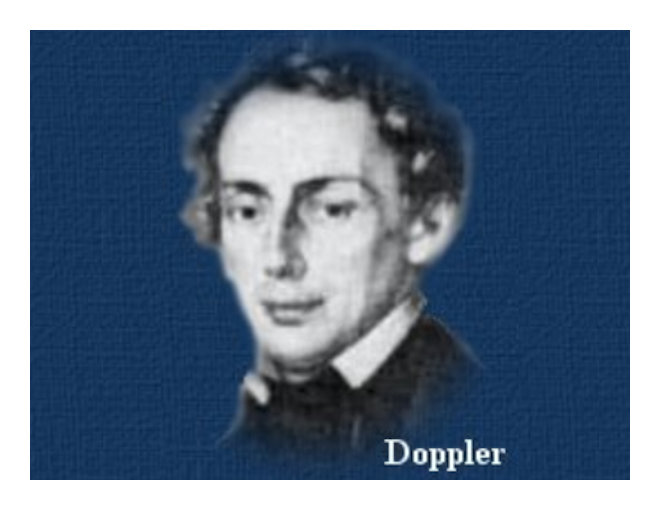Doppler Johann Christian Andrea
Célébrités en cardiologie
(Celebrities in cardiology)

Doppler Johann Christian Andrea. © Heart and Coeur ©
 Doppler Johann Christian Andrea
Doppler Johann Christian Andrea
Découverte de l' effet Doppler
Johann Christian Andreas Doppler (le 29 novembre 1803 au 17 mars 1853) était un mathématicien et un physicien autrichien célébre pour l'hypothése de ce qui est maintenant connu comme l'effet Doppler.
Le physicien autrichien remarque que lorsqu'une source sonore se déplace vers un observateur, la fréquence de l'onde augmente.
Le son monte alors dans les aigus. De même une source qui s'éloigne produit un son plus grave. En 1842, Doppler décrit mathématiquement ce phénoméne. C'est "l'effet Doppler".
Fils d'un maçon, Johann Christian Doppler montre trés tât des facilités pour les mathématiques. A l'âge de dix-huit ans, il est accepté à l'Institut polytechnique de Vienne.
Puis, aprés trois années d'études, il rentre à Salzbourg et poursuit seul ses études de physique et de mathématiques.
De retour à Vienne en 1829, Doppler occupe le poste d'assistant en mathématiques et rédige ses premiers textes en mathématiques et en électricité.
Mais désespérant d'obtenir sa titularisation, il décide en 1835 d'émigrer aux Etats-Unis. C'est au moment de quitter le vieux continent que le lycée de Prague lui propose d'enseigner les mathématiques. Renonçant à son voyage, Doppler professe successivement les mathématiques à l'Ecole technique de Prague en 1841 et la physique et la mécanique à l'Académie des Mines de Chemnitz en 1847.
L'année suivante, il échange ce titre pour celui de professeur de géométrie pratique à l'Institut polytechnique de Vienne et devient le directeur du nouvel Institut de physique en 1850.
Il mourra trois ans plus tard d'une maladie le 17 mars 1850.
Note:
J.C. Doppler a formulé l'hypothése que la fréquence des ondes acoustiques (le son) provenant d'une source en mouvement s'accrossait en s'approchant de l'observateur, et diminue en s'en éloignant. Il avait vu juste. Ceci se produit lorsqu'un train passe en actionnant son sifflet. Le ton du sifflet monte à mesure que le train s'approche de l'observateur fixe et baisse de façon sensible lorsqu'il s'en éloigne. Ce phénoméne se produit parce que, lorsque le train s'approche de l'observateur, le mouvement du train se combine au déplacement de l'onde sonore et la comprime. Lorsque le train s'éloigne, le ton baisse parce que l'onde sonore entendue par l'observateur n'est plus comprimée par le mouvement. Il s'agit d'une variation de fréquence, qu'on appelle maintenant effet Doppler.
 Doppler Johann Christian Andrea
Doppler Johann Christian Andrea
Discovery of the Doppler effect
Johann Christian Andreas Doppler (November 29, 1803 – March 17, 1853) was an Austrian mathematician and physicist, most famous for
The hypothesis of what is now known as the Doppler effect which is the apparent change in frequency and wavelength of a wave that is perceived by an observer moving relative to the source of the waves.This is where we get the Doppler Effect.
Christian Doppler was born in Salzburg as the son of a stone-mason. However he could not work in his father's business because of his generally weak physical condition.
After completing high school he studied astronomy and mathematics in Vienna and Salzburg and started to work at the Prague Polytechnic (now Czech Technical University), where he was appointed professor for mathematics and physics in 1841.
Only one year later at the age of 39 he published his most notable work on the Doppler effect (for instance to be noticed in the change of sound of a quickly passing vehicle). In his time in Prague as professor he published more than 50 articles in mathematics, physics and astronomy.
His research career in Prague was interrupted by the revolutionary incidents of March 1848, when he fled to Vienna. There he was appointed head of the Institute for Experimental Physics at the University of Vienna in 1850. During his presence at the University of Vienna, Doppler, along with Franz Unger, played an influential role in the development of young Gregor Mendel who later became the founding father of genetics.
He died in Venice at age 49 on March 17, 1853.
- §:
C. Doppler hypothesized that the frequency of acoustic (sound) waves from a moving source would increase as they approached an observer, and decrease as they moved away. He was right. It happens when a train passes, blowing its whistle as it goes by. The whistle's pitch climbs as the train comes towards the listener and drops noticeably as it speeds away. This occurs because as the train approaches the listener, the motion of the train combines with the motion of the sound wave and compresses it. When the train speeds away the pitch of the sound drops because the sound wave which the listener hears is no longer being compressed by the motion. This process is called a frequency shift and is known as the Doppler effect.



